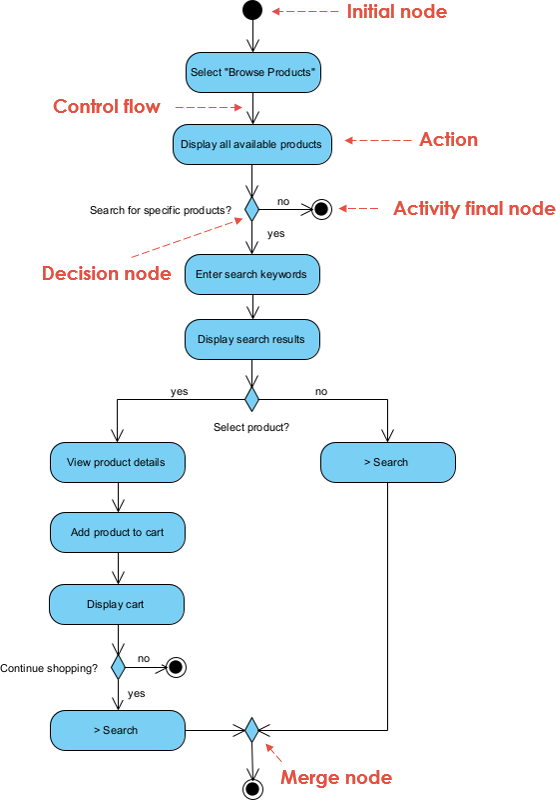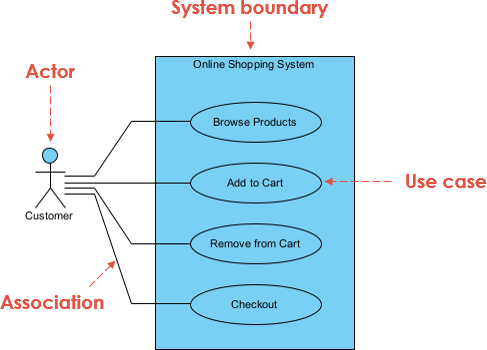Elaborating Use Cases with Activity Diagrams: Visualizing Scenarios for Normal, Alternative, and Exception Paths
What is an Activity Diagram
Activity diagrams are a powerful tool for visualizing the flow of activities within a system or process. They are commonly used in software development to help developers and stakeholders understand the behavior of a system or application. Activity diagrams can also be used to elaborate on use cases and their scenarios, including normal, alternative, and exception scenarios.
Understanding the Relationship Between Use Case Descriptions and Activity Diagrams
Use case and Use Case description
- A use case is a description of a system’s behavior from the perspective of an external actor or user. It outlines the steps involved in achieving a specific goal or task. Use cases can be broken down into three types of scenarios: normal, alternative, and exception scenarios.
- Normal scenarios describe the expected flow of events in a use case. They outline the steps a user would take to complete a task successfully. Alternative scenarios describe different paths a user might take to achieve the same goal. These scenarios might involve different user inputs or different system responses. Exception scenarios describe situations where something goes wrong in the process, such as an error message or a system failure.
Elaborating an use case with Use Case Description
- Activity diagrams can be used to elaborate on these scenarios, providing a visual representation of the steps involved in each scenario. The diagram can include nodes, which represent activities or actions, and edges, which represent the flow of control between activities. The use of activity diagrams can help stakeholders better understand the use case and identify any potential issues or challenges.
- In a normal scenario, the activity diagram would detail the steps taken by the user to complete the task successfully. For example, if the use case involves a user signing up for a newsletter, the activity diagram might include nodes for entering an email address, clicking a submit button, and receiving a confirmation message. The edges between the nodes would represent the flow of control between these activities.
- In an alternative scenario, the activity diagram would detail the steps taken by the user to achieve the same goal using a different path. For example, if the user is unable to sign up using the web form, they might be directed to a phone number or email address to sign up instead. The activity diagram would include nodes for these alternative paths and the edges between them.
- In an exception scenario, the activity diagram would detail the steps taken by the user to recover from an error or failure in the process. For example, if the user receives an error message during the sign-up process, the activity diagram might include nodes for reviewing the error message, correcting the information entered, and resubmitting the form. The edges between the nodes would represent the flow of control between these activities.
An Example – Online Shopping Cart System
Problem Description:
An e-commerce company wants to create an online shopping cart system that allows customers to purchase products online. The company needs to develop a system that can handle a large number of transactions and provide an easy-to-use interface for customers. The system should also be able to handle multiple payment methods, such as credit cards and PayPal.
The problem with developing an online shopping cart system is that it involves complex use cases. The system needs to be able to handle different user roles, such as customers, administrators, and suppliers. Customers need to be able to add items to their cart, view their cart, and checkout. Administrators need to be able to manage products, customers, and orders. Suppliers need to be able to manage their inventory and update product information.
Another challenge with online shopping cart systems is ensuring the security of customer information. The system needs to be designed to protect sensitive information, such as credit card numbers and personal data.
Finally, the system needs to be scalable and able to handle a growing number of users and transactions. The company needs to plan for future growth and ensure that the system can handle increased traffic and demand.
Overall, the challenge with developing an online shopping cart system is to create a comprehensive and accurate description of the system’s requirements while balancing the needs of customers, administrators, and suppliers. The system needs to be easy to use, secure, and scalable to meet the needs of a growing e-commerce business. Use case modeling and analysis is an essential tool for ensuring that all requirements are captured and the system is designed to meet the needs of its users.
Create a Use Case Diagram for the Online Shopping System
Elaborate the Browse Product Use Case with an Activity Diagram
A use case description is a document that outlines the steps involved in a particular use case, including preconditions, postconditions, alternative flows, exceptions, special requirements, and assumptions. We use a use case description to detail a use case because it provides a clear and structured understanding of how the use case functions, what it requires, and what its outcomes are.
Develop the Use Case Description
————————————————————————————————————————————-
Use Case Name: Browse Products
Actors: Customer
Description: This use case describes the process by which a customer can browse products in the online shopping system. The customer can view all available products or search for specific products using keywords.
Preconditions:
- The customer has access to the online shopping system.
Basic Flow of Events:
- The customer selects the “Browse Products” option from the main menu.
- The system displays a list of all available products.
- The customer can scroll through the list or use the search function to find specific products.
- The customer can view product details, such as price, description, and images.
- The customer can select a product to add it to their cart.
Postconditions:
- The customer has viewed all available products or found the specific product they were looking for.
- The customer can add a selected product to their cart or continue browsing products.
Alternative Flows:
- If there are no products available, the system displays an error message and prompts the customer to try again later.
- If the customer’s search does not return any results, the system displays an error message and prompts the customer to try a different search term.
Exceptions:
- None.
Special Requirements:
- None.
Assumptions:
- The customer has a basic understanding of how to browse products on a website.
- The online shopping system has up-to-date product information and is functioning properly.
—————————————————————————————————————————————
As you can see, a use case description helps to:
- Define user requirements: A use case description helps to define the requirements of the system from the user’s perspective, enabling developers to design a system that meets the needs of the users.
- Communicate system functionality: A use case description provides a clear and concise way to communicate the functionality of the system to stakeholders, including developers, designers, and business analysts.
- Identify potential issues: By detailing the preconditions, postconditions, alternative flows, exceptions, special requirements, and assumptions of a use case, a use case description can help to identify potential issues, such as errors or inconsistencies, in the system design.
- Guide system testing: A use case description can also be used to guide system testing by providing a clear set of steps to follow and expected outcomes to achieve.
Overall, a use case description is an important tool for ensuring that the system design meets user requirements, is communicated effectively to stakeholders, and is thoroughly tested for potential issues.
Elaborate the Browse Product Use Case with an Activity Diagram
Creating an activity diagram based on the use case description of a use case is often easier than creating one from scratch because the use case description provides a clear and structured understanding of the steps involved in the use case. Specifically, the use case description outlines the preconditions, postconditions, alternative flows, exceptions, special requirements, and assumptions of the use case, which can be used to create a detailed and accurate activity diagram.

Here are some reasons why creating an activity diagram based on the use case description of a use case is easier:
-
- Clear understanding of the use case: The use case description provides a clear understanding of the steps involved in the use case, making it easier to create an accurate activity diagram.
- Consistency: By using the use case description as a basis for the activity diagram, you can ensure that the diagram is consistent with the requirements outlined in the use case description.
- Time-saving: Creating an activity diagram from scratch can be time-consuming, but by using the use case description as a starting point, you can save time and effort.
- Collaboration: Using a use case description as a basis for the activity diagram can facilitate collaboration among team members, as everyone is working from the same set of requirements.
Overall, creating an activity diagram based on the use case description of a use case is often easier because the use case description provides a clear understanding of the steps involved in the use case, ensuring accuracy and consistency, saving time and effort, and facilitating collaboration among team members.
Summary
In this article, we explore the development of an online shopping cart system, with a focus on the Browse Products use case. We begin by outlining the key aspects of the use case, including preconditions, postconditions, alternative flows, exceptions, special requirements, and assumptions.
This provides a solid foundation for elaborating on the use case through the creation of an activity diagram, which models the process of browsing products within the system. The activity diagram shows how users can select the “Browse Products” option, view all available products, search for specific items, access product details, and add products to their cart.
By providing a step-by-step overview of the design process, this article offers valuable insights into the creation of an effective online shopping system.


